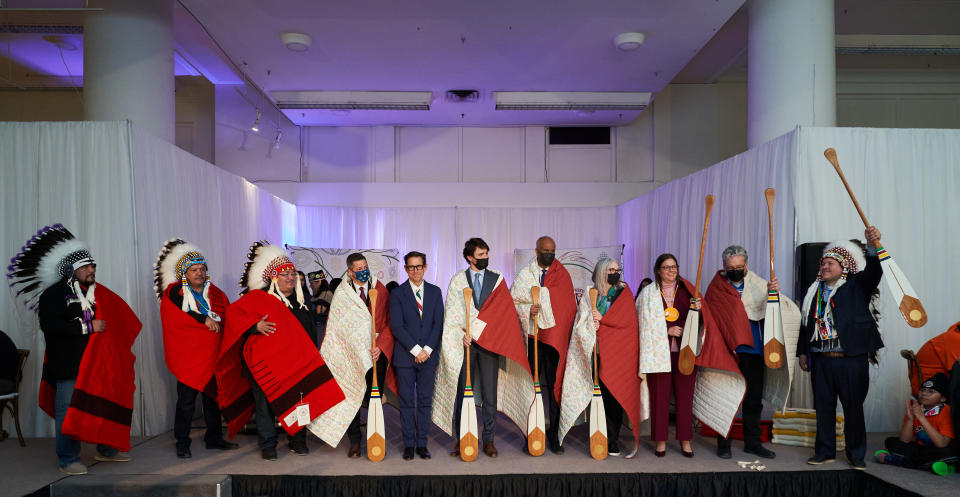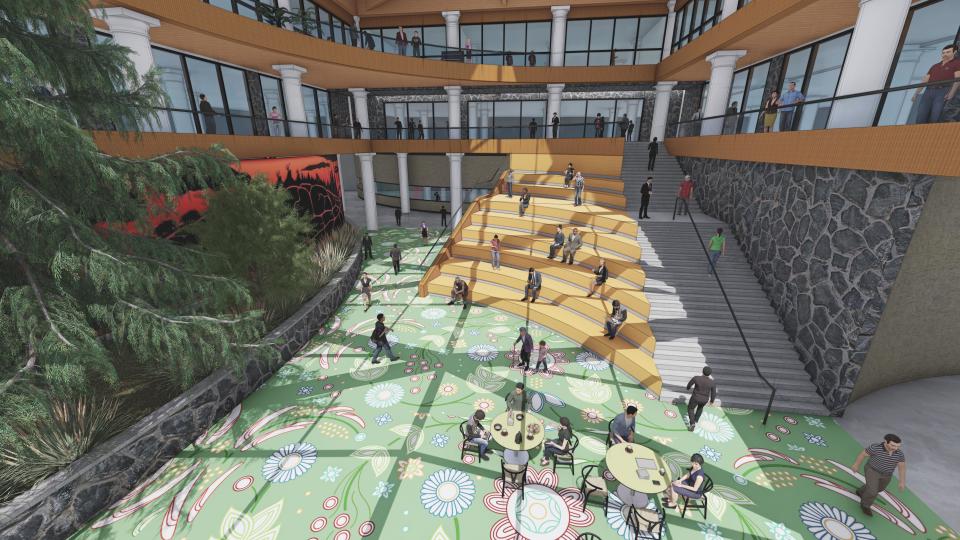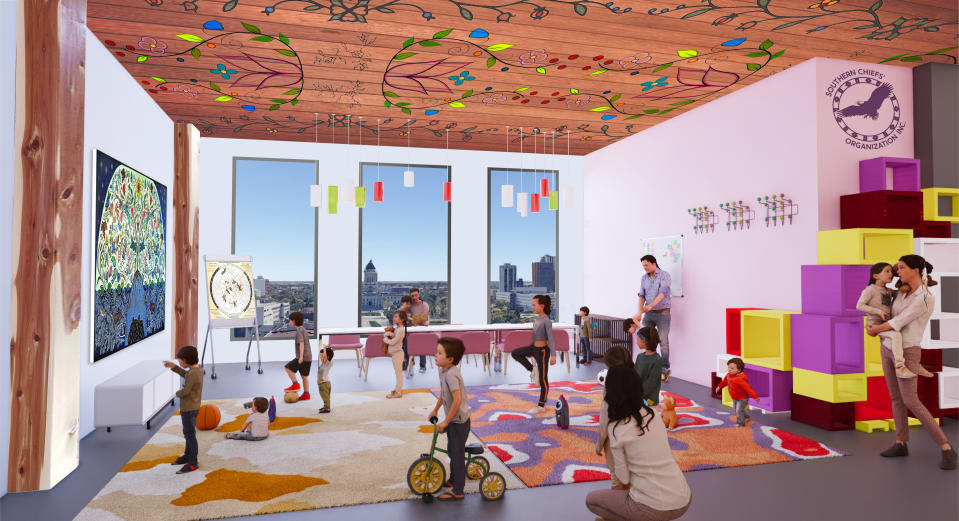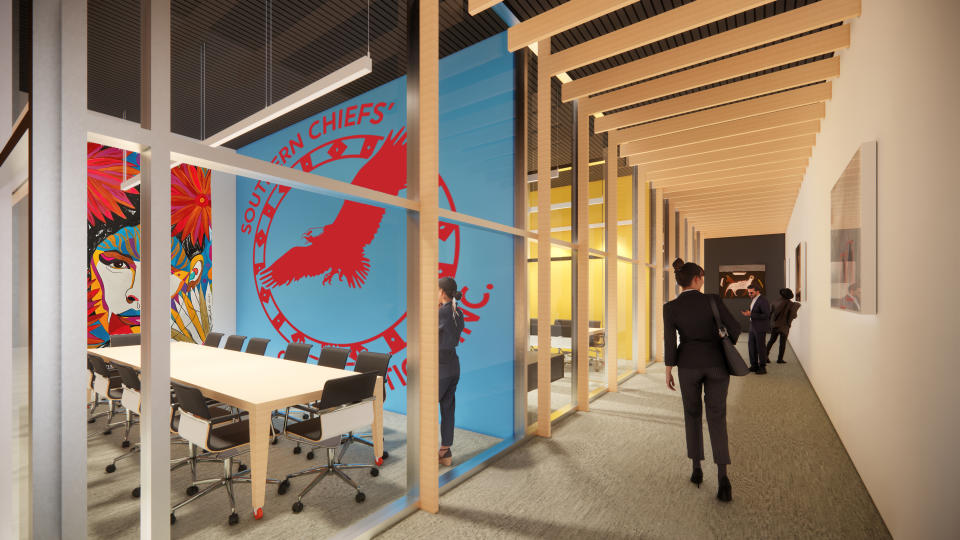HBC Donates a Flagship Site to Canada’s Indigenous People

The Hudson’s Bay Co. has come up with a meaningful solution for a major piece of unused real estate.
The Toronto-based HBC has donated its six-level, 655,000-square-foot former flagship store in downtown Winnipeg, Manitoba, to the Southern Chiefs’ Organization, which will transform the historic building into a mixed-use site for affordable housing; a health clinic embracing Western and traditional medical practices; a child care center; a museum, and a living art gallery where the First Nations will tell its story.
More from WWD
There will also be a restaurant and a café with a take on First Nations’ cuisine, an atrium brightened by skylights and a rooftop garden where children in the care center can plant their own garden, and residents and employees can get some fresh air.
The Southern Chiefs’ Organization, which represents 34 Anishinaabe and Dakota Nations and more than 81,000 citizens in southern Manitoba, helps to preserve the rights and traditions of the First Nations people.
HBC’s gift to the First Nations, unveiled Friday in a ceremony at the site, is a public act of reclamation and reconciliation to benefit Canada’s First Nations. The 352-year-old Hudson’s Bay played a major role in the white colonization of Canada and the exploitation of indigenous peoples through company’s fur trading activities centuries ago.
Though many retailers have been downsizing for years, a process accelerated by the pandemic and the internet, there is still plenty of unproductive and unused retail space challenging companies to develop alternative uses.
Among those attending Friday’s ceremony in Winnipeg was Canada’s Prime Minister Justin Trudeau; Richard Baker, HBC’s governor and executive chairman; Grand Chief Jerry Daniels, and other First Nations and local officials.
The conversion plan was developed jointly by HBC, federal and First Nations representatives. The project’s working title is “Wehwehneh Bahgahkinahgohn,” which translates to “it is visible.”

“Today can be another step forward to a brighter future, one that reflects what our ancestors dreamed of,” Daniels said. “This project is an act of reconciliation and is our vision to revitalize the heart of Winnipeg’s downtown, for the benefit of all, in line with our traditional, holistic approach to sustainable economic development.”
“As we considered the future for the Winnipeg building, it was important to ensure a sustainable plan for the site that also had meaningful purpose for the city of Winnipeg,” Baker said. “HBC’s truth and reconciliation journey requires actions that demonstrate our commitment to moving forward together with Indigenous communities. We believe SCO is the right steward for this location, and can create a new community landmark that will help advance reconciliation.”
Canada does have a dark history of about 100 years of separating Indigenous children from their families and forcing them to attend residential schools and assimilate into Canada’s white culture. Many children were mistreated and died in the schools, and unmarked graves have been discovered. The SCO project will be a place of reflection, to honor those children who survived and those who didn’t.
Through the spread of the COVID-19 virus, the First Nations people suffered disproportionate economic, health and social hardships. Officials said the Winnipeg project will create more than a million working hours during the construction phase, putting people back to work after the pandemic.
“Everyone deserves a safe and affordable place to call home,” Trudeau said. “By reimagining the iconic Hudson’s Bay Company building in Winnipeg’s downtown core, the southern Chiefs’ Organization is helping preserve this historic building, while creating almost 300 much-needed housing units for members of the Southern First Nations in Manitoba.”
“With this project, we are working with HBC and creating a new way of living and working together with treaty partners to create better outcomes for us all,” said Peguis First Nation Chief Glenn Hudson, member of the SCO chiefs’ executive committee. “This will be a new beginning for our people, for this important heritage building, and for everyone who will be brought together to live, work and visit this groundbreaking space.”
“At the center of Canada and at the crossroads of an Indigenous meeting place that is thousands of years old, Winnipeg is leading the way forward on Canada’s journey of reconciliation and today’s announcement is another step in the right direction,” said Winnipeg Mayor Brian Bowman.

The project will incorporate technologies to support a 35 percent reduction in energy consumption and an 81 percent reduction in greenhouse gas emissions to align with First Nation values of treading lightly on the Earth. Also, the historic facade will be preserved.
“It’s been a difficult year for us all, but we are resilient and continue to work toward a better future,” added Sagkeeng Anicinabe Chief Derek Henderson, member of the SCO Chiefs’ executive committee.
The building will also become the future Governance House for the Chiefs of the southern First Nations, the voice for 34 Anishinaabe and Dakota Nations, and more than 81,000 First Nation citizens, representing 10 percent of all First Nation people in Canada.
HBC closed the Winnipeg flagship in November 2020. The site, located on Portage Avenue at Memorial Boulevard, was opened on Nov. 18, 1926, replacing the HBC store that had operated on Main Street since 1881.

According to HBC records, construction of the store involved 300 men, 120 teams of horses, 20 trucks and two steam shovels to excavate 150,000 tons of earth to lay the foundation. One hundred and fifty-one concrete pillars were driven by hand down 52 feet to bedrock to support the building; and 2 million feet of lumber, 100,000 tons of concrete, and 125,000 cubic feet of Tyndall limestone went into the construction. At the time, the structure was the largest reinforced concrete building in Canada, with 15 acres of floor space. At the time, Hudson’s Bay had only 11 stores in Canada — there are currently 85 — and the Winnipeg site was one of the original six flagships.
The Winnipeg store was considered modern at the time of its construction, containing a dozen elevators in two banks of six each, facing each other in a concave arrangement; a beauty parlor; public telephones; restaurants; a post office, and a library. The lobbies were decorated with immense murals depicting scenes of the company’s early history by artists Adam Sheriff Scott and Edward Tappan Adney. On opening day, the 2,000 staff members welcomed 50,000 customers. Soon after the opening, an auditorium with its own orchestra was added, and an aerial navigation beacon was installed, shining a light 200 feet into the sky that could be seen up to 100 miles away. It was first lit March 3, 1930 — “Beacon Day,” marking the inaugural airmail flight from Winnipeg to Calgary. In 1948, one bank of elevators was removed to install escalators. The flagship also operated the first liquor outlet in a department store in Canada.
In January 2019, Winnipeg’s city council voted to give the store official heritage status, protecting the building’s exterior limestone walls, the outside canopy and the curved elevator lobby, among other interior elements.

Sign up for WWD's Newsletter. For the latest news, follow us on Twitter, Facebook, and Instagram.

